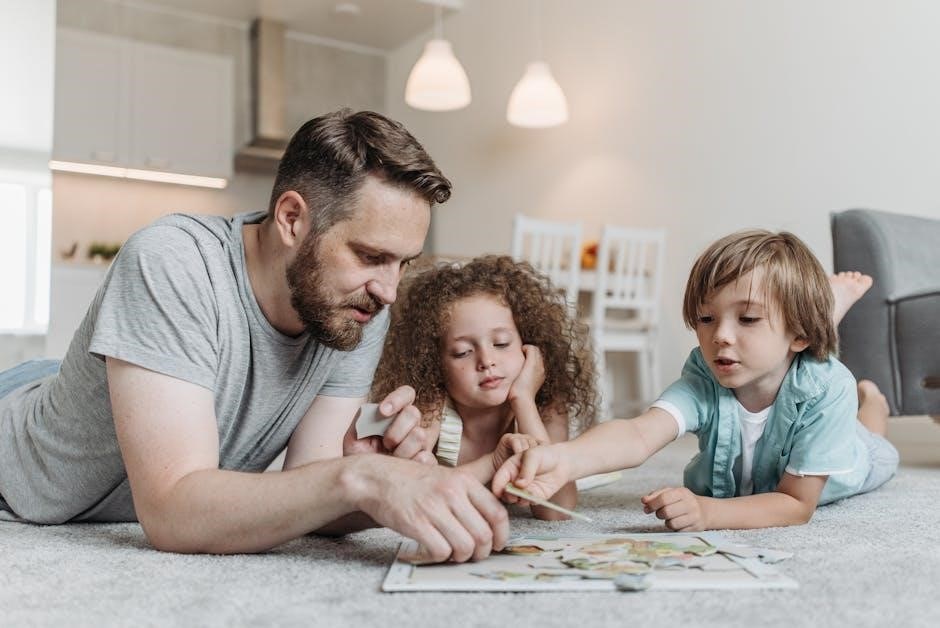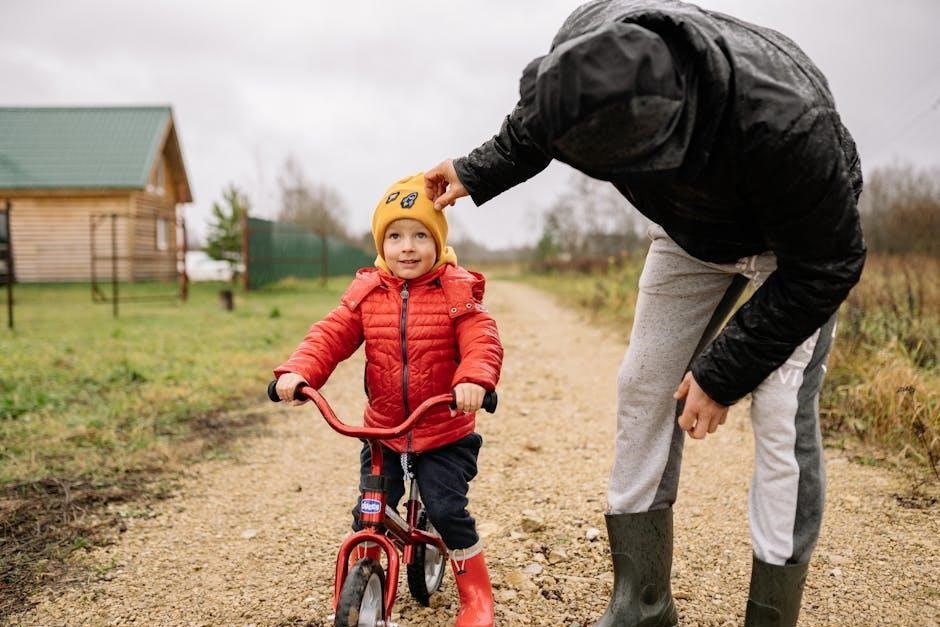Embark on an exciting journey into the world of dogs! This guide is packed with fun facts, helpful tips, and adorable pictures; Learn about breeds, care, and training;
Have you ever wondered why dogs are often called “man’s best friend?” Well, get ready to discover all the amazing reasons why! Dogs are more than just pets; they are loyal companions, playful pals, and furry family members who bring endless joy to our lives․ They can make us laugh with their silly antics, comfort us when we’re feeling down, and always greet us with wagging tails and wet noses․
Dogs can even help us stay active by encouraging us to go for walks and play fetch in the park․ Plus, they are super smart and can be trained to do all sorts of cool tricks! Get ready to learn all about what makes dogs so awesome!

Understanding Dogs
To truly appreciate dogs, we must understand them! Discover their history, how they communicate, and what makes them tick․ It’s time to become a dog expert!
Dog History: From Wolves to Best Friends
Did you know that dogs evolved from wolves? It’s true! Thousands of years ago, wolves started hanging around humans, and over time, they changed․ These early wolves helped humans hunt and protect themselves․ As humans and wolves spent more time together, they became friends․ Humans started breeding the friendliest wolves, and gradually, these wolves became the dogs we know and love today․ From fierce hunters to cuddly companions, dogs have played a vital role in human history․ They offer unwavering loyalty and affection, truly earning their title as “man’s best friend․” Understanding their origin helps us appreciate our canine pals!
Dog Communication: How to Speak Dog
Dogs can’t talk like us, but they have their own ways of communicating! Learning to “speak dog” means understanding their body language; A wagging tail doesn’t always mean happiness; it can also mean excitement or even warning! Pay attention to their ears, eyes, and mouth․ A relaxed dog will have soft eyes and a loose mouth, while a scared dog might tuck its tail and flatten its ears․ Growling, barking, and whining are also important clues․ By observing these signals, you can better understand what your dog is trying to tell you․ Understanding dog language strengthens your bond!

Choosing the Right Dog
Picking a dog is a big decision! Learn about different breeds and what makes them special․ Consider your lifestyle to find the perfect furry friend․
Different Dog Breeds and Their Personalities
Discover the amazing variety of dog breeds! From playful Labradors who love water to loyal German Shepherds known for their intelligence, each breed has unique traits․ Small breeds like Chihuahuas can be energetic and charming, while larger breeds such as Great Danes are often gentle giants․ Learn about terriers, known for their spirited nature, and poodles, celebrated for their smarts and hypoallergenic coats․ Understanding a breed’s personality can help you find a dog that fits your family․ Explore the world of dogs and find the perfect match for your home and lifestyle․ It’s a fun and rewarding journey!
Considering a Dog’s Needs and Your Lifestyle
Before getting a dog, think about your daily life․ Do you have time for walks, playtime, and training? Different breeds have different energy levels․ Some need lots of exercise, while others are happy with a short stroll․ Consider your living space․ A large dog might not be happy in a small apartment․ Think about who will care for the dog when you are away, and if you have time for grooming․ Also, think about the cost of food, vet visits, and toys․ Choosing the right dog means finding a companion that fits your family’s needs and lifestyle, ensuring a happy life for everyone․
Dog Care Basics
Taking care of a dog involves feeding, grooming, and providing a safe environment․ Learn about what dogs can eat, how to keep them clean, and basic health needs․
Feeding Your Dog: What They Can and Cannot Eat
Proper nutrition is vital for a happy and healthy dog․ Choosing the right food ensures they get the energy and nutrients they need to thrive․ It’s important to know that not all human food is safe for dogs․ Some foods, like chocolate, grapes, and onions, are toxic and can cause serious health problems․
Always stick to high-quality dog food appropriate for their age, size, and activity level․ Consult with your veterinarian about portion sizes and feeding schedules to prevent overfeeding or underfeeding․ Fresh water should always be available․ Avoid giving your dog table scraps or treats that are high in sugar or fat․ A balanced diet keeps your furry friend in top shape!
Grooming: Keeping Your Dog Clean and Healthy
Grooming isn’t just about making your dog look good; it’s also essential for their health and well-being․ Regular brushing helps remove loose fur, preventing mats and tangles, especially for long-haired breeds․ Bathing keeps their skin clean and free from irritants, but avoid over-bathing, as it can dry out their skin․
Nail trimming is crucial to prevent discomfort and mobility issues․ Ear cleaning helps prevent infections․ Different breeds have different grooming needs, so research what’s best for your dog․ Make grooming a positive experience with treats and praise, and your dog will enjoy it! A clean dog is a happy dog!

Training Your Dog
Training is important for a well-behaved and happy dog․ Learn how to teach basic commands and understand positive reinforcement techniques․ Start training early for the best results!
Basic Commands: Sit, Stay, Come
Teaching your dog basic commands like “sit,” “stay,” and “come” is crucial for their safety and your peace of mind․ “Sit” is often the easiest command to start with․ Hold a treat near their nose and move it slightly upwards and backwards, encouraging them to sit․ Once their rear touches the ground, say “sit” and give them the treat․
“Stay” requires your dog to hold their position․ After your dog sits, say “stay” and hold your hand up․ Start with short durations, gradually increasing the time․ Reward them for remaining still․
“Come” is vital for recall․ Use a cheerful tone and say “come,” while gently pulling them towards you on a leash․ Reward them enthusiastically when they reach you․ Consistency and positive reinforcement are key to success․
Positive Reinforcement: Rewards and Praise
Positive reinforcement is the most effective way to train your dog․ It focuses on rewarding good behavior, making learning fun and enjoyable for your furry friend․ When your dog performs a desired action, immediately offer a reward, such as a tasty treat, enthusiastic praise, or a favorite toy․
The key is timing! The reward should be given within seconds of the behavior you want to reinforce․ Verbal praise like “Good dog!” or a gentle pat can also work wonders․ Remember to be consistent and patient․
Avoid punishment, as it can create fear and anxiety․ Instead, focus on rewarding the behaviors you want to see, and your dog will be eager to learn and please you․ Positive reinforcement strengthens your bond and makes training a positive experience for both of you․

Playing with Your Dog
Playing with your dog is super fun! It helps them stay happy and healthy․ Plus, it’s a great way for you to bond and become best friends․
Fun Games to Play Together
Get ready for tail-wagging fun with these exciting games to play with your dog! First up, there’s fetch, a classic game that dogs love․ Throw a ball or frisbee and watch them race to bring it back․ Next, try tug-of-war with a rope toy․ Make sure to let them win sometimes!
Hide-and-seek is another great option․ Have someone hold your dog while you hide, then call their name and let them find you․ You can also create an obstacle course in your backyard using cones, tunnels, and jumps․ This is great exercise and mental stimulation․
Dog Parks and Socialization
Dog parks are fantastic places for your furry friend to socialize and burn off energy! Before heading to the park, make sure your dog is vaccinated and friendly with other dogs․ It’s also important to supervise them closely while they’re playing․
Socialization is key to a well-adjusted dog․ Exposing them to different people, dogs, and environments from a young age helps them become confident and comfortable․ Dog parks provide a safe space for them to interact with their own kind, learn social cues, and make new friends․ Remember to always clean up after your dog and be mindful of other dogs’ personal space․
Dog Safety
Understanding dog behavior is crucial for safety․ Learn to recognize signs of happiness or stress․ Always be cautious around unfamiliar dogs to prevent accidents․
Understanding Dog Body Language: Happy or Unhappy?
Learning to “speak dog” is about more than just commands; it’s about understanding their feelings! A wagging tail doesn’t always mean happiness; observe the entire body․ Relaxed ears and a loose tail usually indicate a happy dog․ Stiff posture, tucked tail, or bared teeth signal fear or aggression․
Pay attention to their eyes too․ Averting gaze can mean they’re uncomfortable․ Understanding these signals allows you to interact safely and respectfully with any dog, whether it’s your own furry friend or one you meet in the park․ Never approach a dog displaying signs of stress․
Staying Safe Around Unfamiliar Dogs
It’s super important to be cautious around dogs you don’t know․ Always ask the owner for permission before approaching, and let the dog sniff your hand first․ Approach slowly and avoid direct eye contact, which can be seen as a threat․ If a dog seems scared or aggressive, give it space․
Never run from a dog; that can trigger its chase instinct․ Instead, stand still and avoid sudden movements․ If a dog knocks you down, curl into a ball and protect your face․ Remember, not all dogs are friendly, and it’s up to you to stay safe by respecting their boundaries and reading their body language․
